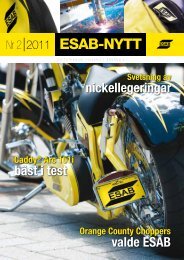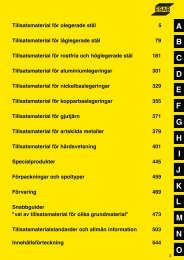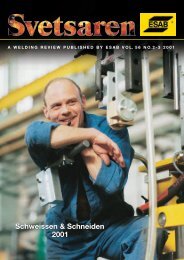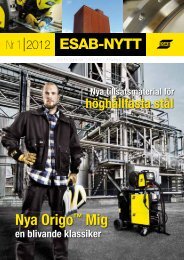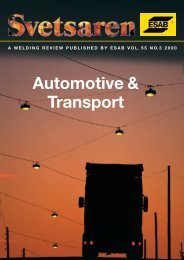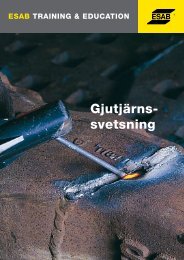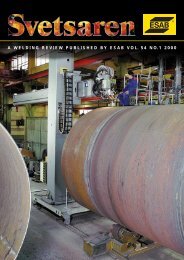FILARC flux - Esab
FILARC flux - Esab
FILARC flux - Esab
- No tags were found...
You also want an ePaper? Increase the reach of your titles
YUMPU automatically turns print PDFs into web optimized ePapers that Google loves.
<strong>FILARC</strong> <strong>flux</strong>- andmetal- coredwelding wiresHealth and safetyContents page 4Previous pageNext pageThe occupational health hazards related to<strong>flux</strong>-cored arc welding, described below,are not very different from those of othermanual and semi-automatic arc weldingprocesses; nor are the precautions weldersshould take to protect themselves.RadiationCored wire welding is often done atcurrents beyond 250A. Radiation is moreintense than with stick electrodes, but it hasroughly the same frequencies, ranging frominfra red to ultra violet. The higher intensitynecessitates the use of darker weldingglasses; typically number 11 or 12. Skinmust be protected against radiation at alltimes.The welding site must be isolated from itssurroundings, for instance by welding curtains.A wire with a low fume emission, willnormally give a more intense radiation. Thisexplains the higher radiation from metalcoredwires.Welding fumesFumes from arc welding consumables consistof various airborne substances (fineparticles or gases) which may presenthealth hazards when inhaled or swallowedin the absence of adequate ventilation andexhaust facilities. The degree of hazard tothe welder depends upon the compositionof the fumes, the concentration in the airthat he is breathing, and the time to whichhe is exposed to it.The chemical composition of the fumes ofwelding consumables, along with extensivesafety information and guidelines, is givenin Safety Data Sheets provided by the manufacturersin accordance with new Europeanrules. In the end of this chapter, youwill find an example of a Safety Data Sheetas provided by <strong>FILARC</strong> Welding Industries.Ceramic backing materials used for rootdeposition do not add to the fumes of weldingconsumables. In fact, it is observed thatfume emission from filler materials is slightlyreduced when welding on ceramic backing.However, attention must be given to stripsthat are attached to the backside of the jointby means of glued aluminium foil. Although,no well researched information is availableabout the toxicity of glue evaporating underthe arc heat, it is wise to treat it as a possiblyhazardous gas and take precautions.The glued aluminium foil used by <strong>FILARC</strong> fortheir ceramic backings, is tested to producenon-toxic fumes.Although not arising from the welding consumableitself, gases like nitric oxide, nitrogendioxide and ozone are produced by thethe heat of the welding arc or its radiation.Especially when using Ar-based mixed gasesor when welding in the short arc mode,radiation can cause a photo-chemical productionof ozone which can enter thebreathing zone of the welder. In the case ofFCAW, ozone formation may occur whenwelding at high currents, or when weldingreflecting materials, and may be increasedwhen using argon rich shielding gases.With FCAW, ozone formation is especiallypronounced when welding in the spray arcmode using shielding gases with a high Arcontent (M12 or M13), or when welding inthe short arc mode (thin plates, root runs,positional welding).Carbon monoxide (CO) may be producedwhen using CO 2 as a shielding gas, or fromthe decomposition of carbonates in <strong>flux</strong>coredwires. In confined spaces, this can leadto CO contents beyond the TLV value; to becounteracted by adequate fume extraction.122



